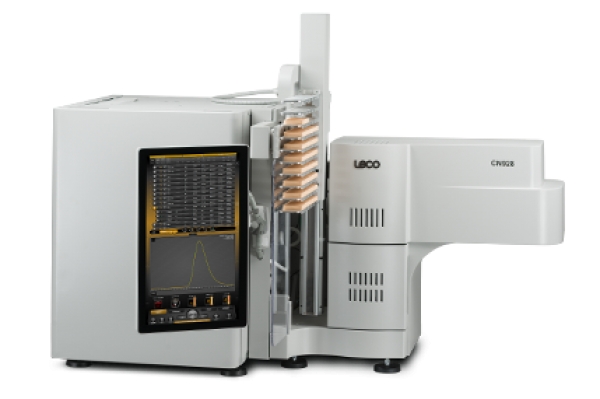928 Series Macro Determinator: Analyze Carbon, Nitrogen, Sulfur, and Proteins by Combustion
Easily handle heterogeneous, difficult to prepare, or low analyte level samples with the 928 Series Macro Determinator for determining Carbon/Nitrogen/Sulfur and Nitrogen/Protein by Combustion. State-of-the-art hardware and our exclusive Cornerstone® touch-screen software platform provide your laboratory with an increase in throughput, uptime, and reliability. Macro sample mass ability (up to 3 grams for Nitrogen/Protein model regardless of sample carbon content) with rapid cycle times and a low cost-per-analysis make the 928 Series ideal for these challenging macro samples.
Features
- Maximize laboratory productivity with unmatched sample throughput
- Rapid cycle time of 5 minutes
- Sample mass:
- FP928: Up to 3.0g (1.0g nominal)
- CN928: Up to 1.0g (0.5g nominal
- CNS928: Up to 0.3g (0.2g nominal)
- Optional 100-sample position autoloader for sequential and non-sequential analysis
- Ergonomic, operator-centered design with boom-mounted touch-screen interface
- Easy access to all reagent tubes and common maintenance areas for simplified maintenance
- Extended reagent lifetimes contribute to a low cost-per-analysis
- Horizontal furnace design with maximum temperatures up to 1450°C ensure complete oxidation of samples
- Expanded furnace efficiency and reliability with a regent-free design
Applications
The 928 series is ideal for the following applications: Meats, Feeds, Forage, Pet Foods, Grains, Milled Products, Starch, Fermentation Products, Dairy and Cheese Products, Soils, Sediments, Fertilizers, Plant Tissue, Filtration Media, Waste Materials, Fiber and Textiles, Resins and Polymers, Paper Products, and Petroleum Products and Additives
Theory of Operation
The 928 series determines Nitrogen and Protein (FP928 model); Carbon and Nitrogen (CN928); or Carbon, Nitrogen, and Sulfur (CNS928) in a multitude of organic matrices from foods and feeds, to soils and fertilizers. The system utilizes a high temperature horizontal ceramic combustion furnace designed to handle macro sample mass with a rapid analysis time delivering unsurpassed application capabilities and throughput.
To start an analysis, a macro-sized sample is weighed into a ceramic boat and placed in the 100-position loader. A fully-automated analysis sequence transfers the sample to a sealed purge chamber, where entrained atmospheric gas is removed. The purged sample is transferred automatically to the furnace, which can be operated at temperatures from 1100°C to 1450°C. To ensure complete and rapid combustion (oxidation) of the sample, the furnace environment is composed of pure oxygen with a secondary oxygen flow directed to the sample via a ceramic lance. The combustion gases are swept from the furnace through a thermoelectric cooler (Nitrogen and Protein [FP]; and Carbon and Nitrogen [CN] models), or an anhydrone reagent (Carbon, Nitrogen and Sulfur [CNS] model), to remove moisture, and collected in a thermostatically-controlled ballast volume.
The gases equilibrate and mix in the ballast before a representative aliquot of the gas is extracted and introduced into a flowing stream of inert gas for analysis. Depending upon the analyzer model, the aliquot gas is carried to a non-dispersive infrared (NDIR) cell for the detection of carbon (as carbon dioxide) and sulfur (as sulfur dioxide), and a thermal conductivity (TC) cell to detect nitrogen (N2). Unlike NDIR cells, the TC cells are chemically non-specific - a series of reagents and scrubbers are used to ensure quantitative detection of N2 without chemical interference. A heated reduction tube, filled with copper, is used to convert nitrogen oxide species (NOx) to N2 and to remove excess oxygen. Carbon dioxide (CO2) is removed by LECOSORB, and water (H2O) is removed by Anhydrone.
Careful sequencing of the analysis by the Cornerstone® brand software provides maximum sample throughput by interleaving the sample loading sequence with quantitation of the aliquot gases from the previous sample. As soon as the combustion gas is collected in the ballast, and the analysis sequence is initiated for the next sample.
The determined composition of the sample is displayed by Cornerstone in weight percent or parts-per-million but can be displayed in other custom units if preferred.
Many diagnostic sensing capabilities are included in the 928 Series analyzer. Multiple Pressure Transducers ensure the presence of sufficient oxygen and helium, and provide the ability to leak-check individual segments of the flow path. Digital Mass Flow Controllers (MFC) are used to control and measure critical flows of oxygen and helium. Thermal sensors and heaters are used to thermostatically control the temperature of critical components, such as the furnace, ballast, dose loop, helium MFC, NDIR cell, and TC cell.
928 Series Details

- FP928
Nitrogen and Protein Analyzer - CN928
Carbon and Nitrogen Analyzer - CNS928
Carbon, Nitrogen, and Sulfur Analyzer
- Boom-Mounted Touch-Screen Interface
- Cornerstone Mobile [PDF]
- SmartLine Remote Diagnostics [PDF]
FP928 Nitrogen/Protein in Flour [PDF] 小麦粉中の窒素とタンパク質 [PDF]
928 Series [PDF] 928シリーズ [PDF]
Explore Organic Consumables, Reference Materials and Standards

